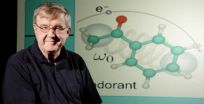(Press-News.org) Researchers from the Research Group on Ruminants led by Elena Albanell, lecturer in Animal and Food Science at Universitat Autònoma de Barcelona, have successfully achieved to prevent sheep and goats from chewing on the young leaves of olive trees and grapevines when grazing. By using the natural mechanism of conditioned taste aversion, researchers redirected the food preferences of ruminants, making them more willing to eliminate undesirable plants from these types of pastures, and thereby reducing the use of pesticides and farming equipment.
The cultivation of woody plants (olive trees, grapevines, fruit trees, etc.) take up 27% of the cultivated land in Spain (MARM, 2010). This cultivation system permits plants to grow around the trees or vines, but in order to prevent these plants from becoming a problem for the cultivations, they must be controlled with herbicides and/or farming equipment. In the long term, these practices can cause environmental problems due to the residues they leave behind or to the compactation of soil produced by farming equipment. A more environmentally sustainable and respectful system would be to control these undesired plants with the grazing of sheep and goats. This system would reduce the use of herbicides and fertilisers, given that the droppings of these animals provide many nutrients for the soil and thus could be used as an agricultural resource, as well as favour a better integration between the agricultural and farming sectors.
The negative side to grazing in these pastures are the damages caused by the animals, since sheep and goats are also free to eat leaves and soft shoots and thus affect the amount and quality of the crops. That is why a perfect solution would be the ability to guarantee farmers that these animals pose no threat to their lands and crops while grazing. This was the objective of researchers at the UAB Faculty of Veterinary Medicine when they proposed the use of conditioned taste aversion in the aim of redirecting the food preferences of these ruminants.
A pilot plan prepared by the UAB Service for Experimental Farm and Fields revealed that sheep and goats can be trained not to not eat olive leaves - a food these small ruminants particularly like. This is especially true with goats, since their "browsing" nature leads them to eat shrubs and trees.
Conditioned taste aversion (CTA) is a natural defensive mechanism animals develop when learning which foods are healthy and which are potentially toxic. To achieve this aversion, researchers fed olive leaves and soft shoots to individual animals which had never tasted this food before, and later administered lithium chloride. Lithium chloride is used in humans to treat mental conditions and in animals with the aim of modifying their eating habits.
It simulates the mechanism action of toxic components found in plants, provoking vomits and generating a sensation of indigestion which the animal associates with the new food it has eaten.
The results obtained are very encouraging. With one dosis of lithium chloride, the sheep and goats rejected the olive leaves from the first day and their behaviour differed greatly from the animals in the control group. The aversion lasted over four months. Following this line of research and thanks to the concession of a research project under the "National R&D&I Plan" (AGL2010--22178-C02-01), the project is effectively achieving its goals under commercial conditions, with both animals acquiring aversion for olive leaves and sheep learning to dislike grapevines.
INFORMATION:
Selective grazing and aversion to olive and grape leaves achieved in goats and sheep
2012-09-19
ELSE PRESS RELEASES FROM THIS DATE:
Children with autism experience interrelated health issues, says MU expert
2012-09-19
COLUMBIA, Mo. – One in 88 children has been diagnosed with an autism spectrum disorder (ASD) in the United States, according to the Centers for Disease Control and Prevention. A new study by a University of Missouri researcher found that many children with ASD also experience anxiety, chronic gastrointestinal (GI) problems and atypical sensory responses, which are heightened reactions to light, sound or particular textures. These problems appear to be highly related and can have significant effects on children's daily lives, including their functioning at home and in school.
Micah ...
Weight gain worry for stressed black girls
2012-09-19
Could the impact of chronic stress explain why American black girls are more likely to be overweight than white girls? According to Dr. Tomiyama of the University of California, Los Angeles in the U.S., and her colleagues, higher levels of stress over 10 years predict greater increases in body weight over time in both black and white girls. However, the experience of chronic stress appears to have a greater negative effect on black girls' weight, which may explain racial disparities in obesity levels. The work is published online in Springer's journal, Annals of Behavioral ...
Your memory is like the telephone game
2012-09-19
CHICAGO --- Remember the telephone game where people take turns whispering a message into the ear of the next person in line? By the time the last person speaks it out loud, the message has radically changed. It's been altered with each retelling.
Turns out your memory is a lot like the telephone game, according to a new Northwestern Medicine study.
Every time you remember an event from the past, your brain networks change in ways that can alter the later recall of the event. Thus, the next time you remember it, you might recall not the original event but what you ...
Simple routine could help athletes avoid choking under pressure
2012-09-19
WASHINGTON — Some athletes may improve their performance under pressure simply by squeezing a ball or clenching their left hand before competition to activate certain parts of the brain, according to new research published by the American Psychological Association.
In three experiments with experienced soccer players, judo experts and badminton players, researchers in Germany tested the athletes' skills during practice and then in stressful competitions before a large crowd or video camera. Right-handed athletes who squeezed a ball in their left hand before competing ...
CT scan and 3-D print help scientists reconstruct an ancient mollusk
2012-09-19
Using a combination of traditional and innovative model-building techniques, scientists in the U.S. and a specialist in Denmark have created a lifelike reconstruction of an ancient mollusk, offering a vivid portrait of a creature that lived about 390 million years ago, and answering questions about its place in the tree of life, as described in the Sept. 18 edition of the journal Palaeontology.
The model of the oval-shaped sea creature, called a multiplacophoran, which was covered with stiff plates and a ring of spines, resulted from a collaboration between Jakob Vinther, ...
Diseases of aging map to a few 'hotspots' on the human genome
2012-09-19
Researchers have long known that individual diseases are associated with genes in specific locations of the genome. Genetics researchers at the University of North Carolina at Chapel Hill now have shown definitively that a small number of places in the human genome are associated with a large number and variety of diseases. In particular, several diseases of aging are associated with a locus which is more famous for its role in preventing cancer.
For this analysis, researchers at UNC Lineberger Comprehensive Cancer Center catalogued results from several hundred human ...
Genetically-engineered preclinical models predict pharmacodynamic response
2012-09-19
New cancer drugs must be thoroughly tested in preclinical models, often in mice, before they can be offered to cancer patients for the first time in phase I clinical trials. Key components of this process include pharmacokinetic and pharmacodynamic studies, which evaluate how the drug acts on a living organism. These studies measure the pharmacologic response and the duration and magnitude of response observed relative to the concentration of the drug at an active site in the organism.
A new comparison of four different methodologies for pharmacokinetic and pharmacodynamic ...
Can post-breakup Facebook surveillance delay emotional recovery?
2012-09-19
New Rochelle, NY, September 19, 2012—More than 900 million people worldwide are active users of the social networking site Facebook, and it is estimated that as many as one-third report using Facebook to check on the activities of former romantic partners. The effects of remaining Facebook friends with an ex-lover or even just following their activities online can disrupt a person's ability to heal emotionally and move on with his or her life, according to an article in Cyberpsychology, Behavior, and Social Networking, a peer-reviewed journal published by Mary Ann Liebert ...
Odorant shape and vibration likely lead to olfaction satisfaction
2012-09-19
CHAMPAIGN, Ill. — A new study of the sense of smell lends support to a controversial theory of olfaction: Our noses can distinguish both the shape and the vibrational characteristics of odorant molecules.
The study, in the journal Physical Chemistry Chemical Physics, demonstrates the feasibility of the theory – first proposed decades ago – that the vibration of an odorant molecule's chemical bonds – the wagging, stretching and rocking of the links between atoms – contributes to our ability to distinguish one smelly thing from another.
"The theory goes that when the ...
New airport system facilitates smoother take-offs and landings
2012-09-19
Contact: David Hosansky
303-497-8611
hosansky@ucar.edu
NCAR/UCAR
Zhenya Gallon, NCAR/UCAR Media Relations
303-497-8607
zhenya@ucar.edu
New airport system facilitates smoother take-offs and landings
BOULDER--For airline passengers who dread bumpy rides to mountainous destinations, help may be on the way. A new turbulence avoidance system has for the first time been approved for use at a U.S. airport and can be adapted for additional airports in rugged settings across the United States and overseas.
The system, developed by the National Center for Atmospheric ...




